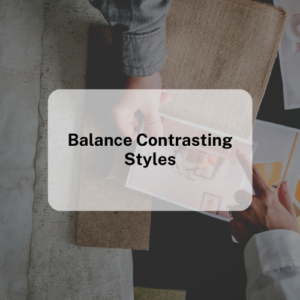Mixing and Matching: How to Combine Different Interior Design Styles
When it comes to interior design, there are a variety of different styles to choose from. From traditional to modern, rustic to minimalist, each style has its own unique look and feel. But what if you love elements from multiple styles? Can you mix and match different interior design styles to create a cohesive and stylish space? The answer is yes! In this article, we’ll explore how to combine different interior design styles to create a home that’s truly your own.
Start with a Neutral Base

When mixing and matching different interior design styles, it’s important to start with a neutral base. This will provide a cohesive foundation for the various design elements you’ll be incorporating. Choose neutral colors for walls, flooring, and large pieces of furniture. This will allow you to layer in different styles without overwhelming the space.
To add more depth and interest to a neutral base, consider adding texture. The texture is a great way to add visual interest and tactile appeal to a space. Textured fabrics, such as linen, velvet, and chenille, can be incorporated into pillows, throws, and upholstery. Natural textures, such as wood, stone, and metal, can be incorporated into furniture, accessories, and accent walls. Additionally, you can play with different finishes and sheens, such as matte, glossy, and metallic, to add dimension to a neutral space.
Another way to add interest to a neutral base is to play with different shades of the same color. Monochromatic color schemes can be visually stunning and can create a cohesive look and feel. For example, a neutral base of beige walls and white furniture can be elevated by adding beige and cream textiles and accessories. This creates a subtle and sophisticated look that is perfect for a modern or minimalist space.
Identify Your Favorite Styles

The key to successfully mixing and matching interior design styles is to identify the styles that you love the most. Spend some time researching different styles and determining which ones resonate with you. This could be anything from mid-century modern to French country, industrial to coastal. Once you’ve identified your favorite styles, you can begin to incorporate elements from each into your space.
To add more depth to your style preferences, consider looking at different eras and regions. For example, if you’re drawn to mid-century modern design, look at different regions that influenced the style, such as Scandinavian or Japanese design. This will give you a more nuanced understanding of the style and allow you to incorporate different elements into your space.
Incorporate Key Elements

When mixing and matching different interior design styles, it’s important to incorporate key elements from each style. This could be a rustic wooden coffee table, a mid-century modern lamp, or a traditional Persian rug. By incorporating these key elements, you’ll be able to create a space that feels eclectic and unique.
To make sure that the key elements you incorporate work well together, consider their scale, shape, and proportion. For example, if you’re incorporating a large, rustic wooden coffee table, balance it out with more delicate, mid-century modern chairs. This creates a visually interesting and balanced space that feels intentional.
Another way to incorporate key elements is to play with their placement. For example, if you have a traditional Persian rug, try layering it over a modern, geometric rug. This creates a layered and interesting look that combines the best of both styles.
Balance Contrasting Styles

When mixing and matching different interior design styles, it’s important to find a balance between contrasting styles. For example, if you’re incorporating elements of both rustic and modern design, you’ll want to ensure that the overall look and feel of the space are cohesive. This could mean balancing out the rough textures of a rustic piece with the sleek lines of a modern piece.
To balance contrasting styles, consider creating a focal point in the space. This could be a large piece of furniture, such as a sofa or a bed, or a statement piece of artwork or lighting. By creating a focal point, you’ll be able to anchor the space and bring together the different design elements.
Another way to balance contrasting styles is to play with symmetry and asymmetry. Symmetry creates a sense of order and balance, while asymmetry creates a sense of movement and interest.
Don’t Be Afraid to Experiment

Finally, when mixing and matching different interior design styles, it’s important to not be afraid to experiment. Design is all about taking risks and trying new things. If you’re unsure about how to mix different styles, start small. Incorporate one or two elements and see how they work together. From there, you can continue to add more elements and refine your design.
In conclusion, mixing and matching different interior design styles can be a fun and exciting way to create a space that’s uniquely your own. By starting with a neutral base, identifying your favorite styles, incorporating key elements, balancing contrasting styles, using color to tie everything together, layering textures and patterns, and not being afraid to experiment, you’ll be able to create a space that feels cohesive and stylish.